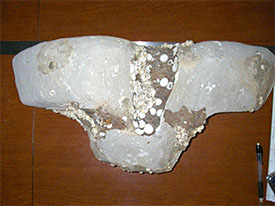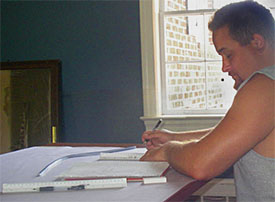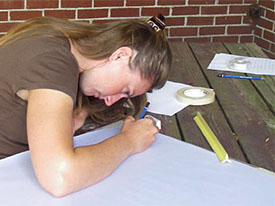
East Carolina University 2007 Field School
in Underwater Archaeology
28 May 2007
By Jeremy Eamick
The beginning of Memorial Day is usually associated with warm weather, tasty grilled food, and lazy enjoyment around a pool. The professors of ECU’s summer field school orchestrated a different set of activities for us today in celebration of this wonderful holiday. Artifact drawing was the leading task of the day, with packing and preparation included to allow for tomorrow’s early morning departure.

Stern box top view.
The last week was spent working on the Washington Park vessel. During this time two artifacts were discovered. These artifacts were considered interesting enough to warrant recording. The team duties for today included the recording of these artifacts in picture forms. These artifacts were a possible wooden rudder and the cement stern box from the site. We were broken up into teams of two, with Mel and Nadine assigned the rudder while Steve and I were assigned the stern box.

Jeremy Eamick works on the stern box drawings inside Eller House.
Sadly, Steve and I remained busy throughout the day inside the Eller house conference room. The small size of our artifact, a measly 24 inches long and 7 inches tall, allowed us to work on an indoor table. We missed out on the wonderful weather because of our work ethic. Instead, we laid out a large piece of graph paper and placed the stern box on the conference table. Steve opened the window shades and turned on the lights to provide the best available light for drawing; it worked well for us in the shading of the artifact.

Nadine drawing on her glass board.
The first task we undertook was to outline the goals of our drawing. We needed three drawings for the record. A plan view from directly overhead, a frontal view, and a side view. The frontal view was the easiest to reproduce since it had the least features to work on. The side view was problematic from the shading needs that cropped up to match the unusual curves. The plan view was a blunder that took hours to correct.
The plan view was the most difficult since Steve and I were inexperienced and we made many mistakes. Primarily we planned to use a scale that measured in tenths of a foot, but we plotted points on the artifact using inches and tenths of a foot. These mistakes lead to a skewed drawing that was deformed and nothing similar to the artifact. We discovered after a few more attempts what the mistake was and we were able to correct the points and move on after a few hours. This drawing also included accurate measurements of the shaft that ran through the cement and the concretions that remained on it. Eventually this drawing took several hours to complete and garnered the most curse words.

ECU Staff Archaeologist Calvin Mires assisting Steve Dilk on artifact shading.
My team did participate in some of the preparation for the next day. A new towed trailer had been purchased by the Maritime Program for the future field schools this past year. The professors decided to utilize this tool and we helped load tanks into the trailer and later the tool boxes. This part of the project was only a few minutes of work for Steve and me since we were more dedicated to the drawings. The rest of the loading work was finished by Calvin, Adam, and Michelle.
The side drawing was also a problem since it portrayed the abundant curves and bends that ran over the stern box. Shading is needed to differentiate these curves and to supply dimension to the drawing. Steve and I were perplexed at this problem and requested assistance from Calvin. After a short while we were able to understand the nuisances of shading and completed the drawings at the end of the day.
I truly enjoyed this day. To me, this project is very exciting. Granted I have minimal experience in artifact drawing, yet the enjoyment from actually participating in something so important to archaeology really made the day enjoyable. In fact this day passed very quickly and the stern box was finished by 3 pm. Nadine and Mel were unable to finish their project since it was such a large artifact and very feature intensive. The artifact was 2 by 3 feet and was kept outside. The ladies prepared with a lathering of sun lotion while we remained indoors next to the managers who remained active to help us out. Overall, I am glad to receive this experience since further work in the field will require that I know how to draw. Hopefully I will improve upon my abilities sooner; the first few attempts were not pristine or legible.
Please feel free to contact us at mua@keimaps.com with any comments, questions, or suggestions during the weeks to come.
Return to Project Journal home page.

